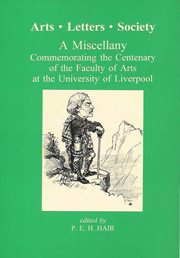 Arts - Letters - Society
Arts - Letters - Society The studies of the Faculty, in our beginnings, were defined as Languages, Literature, History, Economics, Philosophy, Education, Art and Architecture. Of these Economics, Education, Art and Architecture now belong to our sister-faculty, the Faculty of Social and Environmental Studies. Archaeology and Music have joined us over the years, and different specific languages have come and gone - though there are still staff concerned with some of the lost fields. The division between Arts and Humanities on the one hand, and Social and Environmental Studies on the other, ensures that three Institutes (of Latin-American, Popular Music and Irish Studies) sit a little outside the formal Faculty structure, and that some Departments and some scholars feel a dual allegiance. Most outsiders - reasonably enough - assume that an Arts Faculty must have something to do with Art, but a more accurate list would now read ‘Languages, Literature, History, Philosophy, Archaeology and Music’ (variously contained in different Departments). In celebrating a hundred years of scholarship the present Faculty recalls a larger past, and conceives a future.
The centennial celebrations (no doubt to be repeated when some other Founding Moment is remembered) have coincided with the Government's decision to cut back, or privatise, the growth of Universities - restoring, some may think, the situation where we first began: reliant on the generosity of benefactors, and the enthusiasm of scholars. We aim not to lose any further areas of expertise, and even to retrieve some.
To save this book to your Kindle, first ensure [email protected] is added to your Approved Personal Document E-mail List under your Personal Document Settings on the Manage Your Content and Devices page of your Amazon account. Then enter the ‘name’ part of your Kindle email address below. Find out more about saving to your Kindle.
Note you can select to save to either the @free.kindle.com or @kindle.com variations. ‘@free.kindle.com’ emails are free but can only be saved to your device when it is connected to wi-fi. ‘@kindle.com’ emails can be delivered even when you are not connected to wi-fi, but note that service fees apply.
Find out more about the Kindle Personal Document Service.
To save content items to your account, please confirm that you agree to abide by our usage policies. If this is the first time you use this feature, you will be asked to authorise Cambridge Core to connect with your account. Find out more about saving content to Dropbox.
To save content items to your account, please confirm that you agree to abide by our usage policies. If this is the first time you use this feature, you will be asked to authorise Cambridge Core to connect with your account. Find out more about saving content to Google Drive.